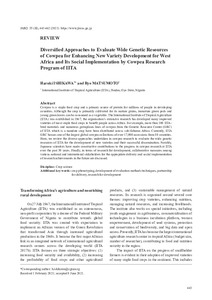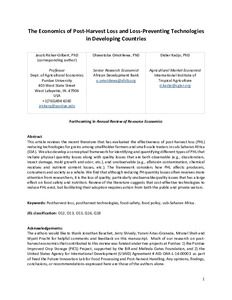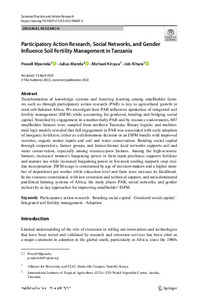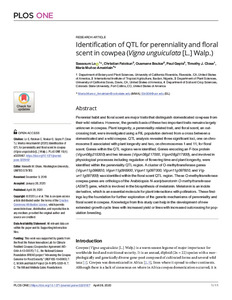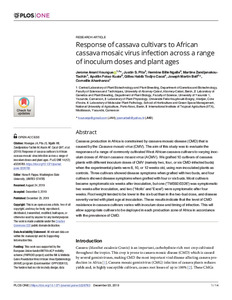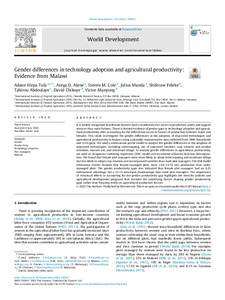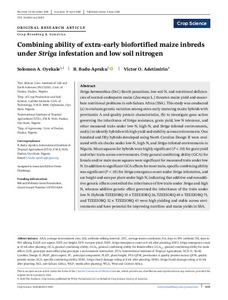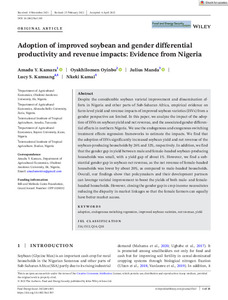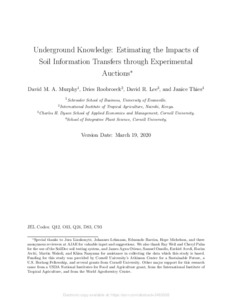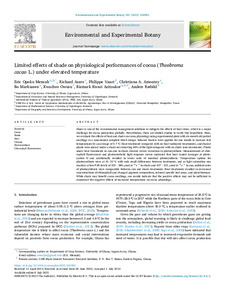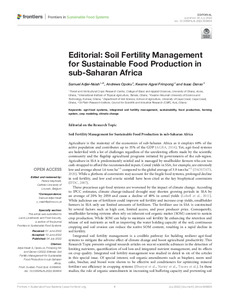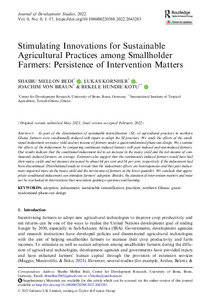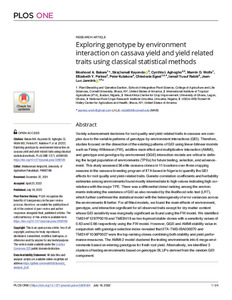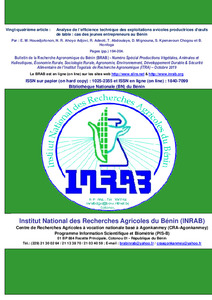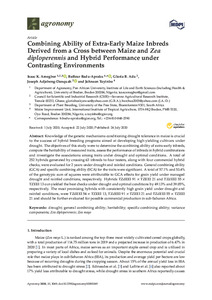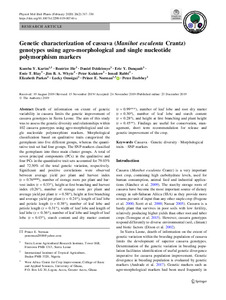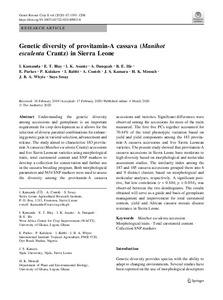Welcome to the International Institute of Tropical Agriculture Research Repository
Journal and Journal Articles: Recent submissions
Now showing items 681-700 of 5266
-
Diversified approaches to evaluate wide genetic resources of cowpea for enhancing new variety development for west Africa and its social implementation by cowpea research program of IITA
(2021)Cowpea is a staple food crop and a primary source of protein for millions of people in developing countries. Although the crop is primarily cultivated for its mature grains, immature green pods and young green leaves can be consumed as a vegetable. The International Institute of Tropical Agriculture (IITA) was established in 1967; the organisation’s extensive research has developed many improved varieties of most staple food crops to benefit people across Africa. For example, more than 100 IITA-bred ... -
The economics of post-harvest loss and loss-preventing technologies in developing countries
(2022)This article reviews the recent literature that has evaluated the effectiveness of postharvest loss (PHL)-reducing technologies for grains among smallholder farmers and small-scale traders in sub-Saharan Africa. We also develop a conceptual framework for identifying and quantifying different types of PHL that include physical quantity losses along with quality losses that are both observable (e.g., discoloration, insect damage, mold growth, and odor) and unobservable (e.g., aflatoxin contamination, ... -
Participatory action research, social networks, and gender influence soil fertility management in Tanzania
(2022)Transformation of knowledge systems and fostering learning among smallholder farmers such as through participatory action research (PAR) is key to agricultural growth in rural sub-Saharan Africa. We investigate how PAR influences uptake/use of integrated soil fertility management (ISFM) while accounting for gendered, bonding and bridging social capital. Stratified by engagement in a mother-baby PAR and by resource endowments, 607 smallholder farmers were sampled from northern Tanzania. Binary ... -
Identification of QTL for perenniality and floral scent in cowpea (Vigna unguiculata [L.] Walp.)
(2020-04-28)Perennial habit and floral scent are major traits that distinguish domesticated cowpeas from their wild relatives. However, the genetic basis of these two important traits remains largely unknown in cowpea. Plant longevity, a perenniality-related trait, and floral scent, an outcrossing trait, were investigated using a RIL population derived from a cross between a domesticated and a wild cowpea. QTL analysis revealed three significant loci, one on chromosome 8 associated with plant longevity and ... -
Response of cassava cultivars to African cassava mosaic virus infection across a range of inoculum doses and plant ages
(2019-12-23)Cassava production in Africa is constrained by cassava mosaic disease (CMD) that is caused by the Cassava mosaic virus (CMV). The aim of this study was to evaluate the responses of a range of commonly cultivated West African cassava cultivars to varying inoculum doses of African cassava mosaic virus (ACMV). We grafted 10 cultivars of cassava plants with different inoculum doses of CMV (namely two, four, or six CMD-infected buds) when the experimental plants were 8, 10, or 12 weeks old, using ... -
Gender differences in technology adoption and agricultural productivity: evidence from Malawi
(2022-11)It is widely recognized that female farmers have considerably less access to productive assets and support services than male farmers. There is limited evidence of gender gaps in technology adoption and agricultural productivity after accounting for the differential access to factors of production between males and females. This study investigates the gender differences in the adoption of improved technologies and agricultural productivity in Malawi using nationally representative data collected ... -
Combining ability of extra‐early biofortified maize inbreds under Striga infestation and low soil nitrogen
(2020-07)Striga hermonthica (Del.) Benth parasitism, low soil N, and nutritional deficiencies of normal‐endosperm maize (Zea mays L.) threaten maize yield and exacerbate nutritional problems in sub‐Sahara Africa (SSA). This study was conducted (a) to evaluate genetic variation among extra‐early maturing maize hybrids with provitamin A and quality protein characteristics, (b) to investigate gene action governing the inheritance of Striga resistance, grain yield, low N tolerance, and other measured traits ... -
A high plant density and the split application of chemical fertilizer increased the grain and protein content of cowpea (Vigna unguiculata) in Burkina Faso, west Africa
(2022)In West Africa, cowpea (Vigna unguiculata) is an important source of protein for many people. To meet the protein demands, the cowpea yields per unit area and its seed protein content must be increased. We evaluated the effects of the planting density and topdressing (fertilisation) timing on the cowpea yield and its protein content. High density (HD: 40 × 40 cm) and super high density (SHD: 40 × 20 cm) plantings were the most efficient approaches for enhancing cowpea yields. Across different ... -
Adoption of improved soybean and gender differential productivity and revenue impacts: evidence from Nigeria
(2022)Despite the considerable soybean varietal improvement and dissemination efforts in Nigeria and other parts of Sub-Saharan Africa, empirical evidence on farm-level yield and revenue impacts of improved soybean varieties (ISVs) from a gender perspective are limited. In this paper, we analyze the impact of the adoption of ISVs on soybean yield and net revenue, and the associated gender differential effects in northern Nigeria. We use the endogenous and exogenous switching treatment effects regression ... -
Underground knowledge: estimating the impacts of soil information transfers through experimental auctions
(2020-10-06)Soil degradation, a serious environmental problem in many developing countries, often necessitates the use of fertilizers to improve crop yields. However, smallholders usually do not have sufficient information about their soil nutrient levels to make profit‐maximizing decisions about fertilizer usage. We conducted two‐round experimental auctions to determine whether providing information and fertilizer recommendations from inexpensive soil testing kits to farmers in western Kenya affected their ... -
Women eat more rice and banana: the influence of gender and migration on staple food choice in East Africa
(2020-04-28)An original approach was used to examine how staple food choice differs by gender and migration: this consisted of a quantitative survey (six locations with urban consumers from various economic classes (n = 123)), a qualitative in-depth interview with a subset of those consumers (n = 18), and focus group discussions (n = 13). Men and women had similar results in terms of their preferred staple food choice attributes; yet women indicated consuming more rice and banana, and men, more maize and ... -
Limited effects of shade on physiological performances of cocoa (Theobroma cacao L.) under elevated temperature
(2022)Shade is one of the recommended management solutions to mitigate the effects of heat stress, which is a major challenge for cocoa production globally. Nevertheless, there are limited studies to verify this hypothesis. Here, we evaluate the effects of heat and shade on cocoa physiology using experimental plots with six-month old potted seedlings in a randomized complete block design. Infrared heaters were applied for one month to increase leaf temperatures by an average of 5–7 ºC (heat treatment) ... -
Stimulating innovations for sustainable agricultural practices among smallholder farmers: persistence of intervention matters
(2022)As part of the dissemination of sustainable intensification (SI) of agricultural practices in northern Ghana, farmers were conditionally induced with inputs to adopt the SI practices. We study the effects of the conditional inducement on maize yield and net income of farmers under a quasi-randomised phase-out design. We examine the effects of the inducement by comparing continuous induced farmers with past induced and non-induced farmers. Our results indicate that the conditional inducement led ... -
Exploring genotype by environment interaction on cassava yield and yield related traits using classical statistical methods
(2022)Variety advancement decisions for root quality and yield-related traits in cassava are complex due to the variable patterns of genotype-by-environment interactions (GEI). Therefore, studies focused on the dissection of the existing patterns of GEI using linear-bilinear models such as Finlay-Wilkinson (FW), additive main effect and multiplicative interaction (AMMI), and genotype and genotype-by-environment (GGE) interaction models are critical in defining the target population of environments (TPEs) ... -
Analyse de l’efficience technique des exploitations avicoles productrices d’oeufs de table : cas des jeunes entrepreneurs au Bénin
(2019-10)La filière oeuf de table est un secteur d’activité pour de nombreux jeunes entrepreneurs au Bénin. L’objectif de l’étude était d’analyser l’efficience technique et les sources d’inefficience des exploitations des jeunes entrepreneurs produisant des oeufs de table au Bénin. La statistique descriptive et l’approche de frontière stochastique utilisant une spécification de la fonction Cobb Douglas ont été les méthodes utilisées sur des données de panel non cylindrées couvrant la période de 2010 à ... -
The effects of foreign direct investment on youth unemployment in the Southern African Development Community
(2020-07-27)This paper examines the effect of foreign direct investment (FDI) on youth unemployment in the Southern African Development Community (SADC) region using panel data from the World Bank World Development Indicators for the period 1994–2017. Results from the Feasible Generalized Least Squares (FGLS-Parks) technique show that FDI has an insignificant effect on reducing youth unemployment in the SADC region. This could be because the type of FDI in the region is partly mergers and acquisitions, which ... -
Combining ability of extra-early maize inbreds derived from a cross between maize and Zea diploperennis and hybrid performance under contrasting environments
(2020-07-24)Knowledge of the genetic mechanisms conditioning drought tolerance in maize is crucial to the success of hybrid breeding programs aimed at developing high-yielding cultivars under drought. The objectives of this study were to determine the combining ability of extra-early inbreds, compute the heritability of measured traits, assess the performance of inbreds in hybrid combinations and investigate the associations among traits under drought and optimal conditions. A total of 252 hybrids generated ... -
Genetic characterization of cassava (Manihot esculenta Crantz) genotypes using agro-morphological and single nucleotide polymorphism markers
(2019-12-23)Dearth of information on extent of genetic variability in cassava limits the genetic improvement of cassava genotypes in Sierra Leone. The aim of this study was to assess the genetic diversity and relationships within 102 cassava genotypes using agro-morphological and single nucleotide polymorphism markers. Morphological classification based on qualitative traits categorized the germplasm into five different groups, whereas the quantitative trait set had four groups. The SNP markers classified the ... -
Genetic diversity of provitamin-A cassava (Manihot esculenta Crantz) in Sierra Leone
(2020-03-04)Understanding the genetic diversity among accessions and germplasm is an important requirement for crop development as it allows for the selection of diverse parental combinations for enhancing genetic gain in varietal selection, advancement and release. The study aimed to characterize 183 provitamin A cassava (Manihot esculenta Crantz) accessions and five Sierra Leonean varieties using morphological traits, total carotenoid content and SNP markers to develop a collection for conservation and ...

